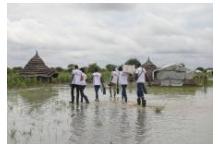The MSF Experience of Climate Change Across South Sudan, Kenya, Honduras, Myanmar, and Mozambique
por Medecins Sans Frontieres Australia“WE SEE IT IN OUR WAITING ROOMS“ The MSF Experience of Climate Change
SOUTH SUDAN: YEAR AFTER YEAR
A fourth consecutive year of flooding left about two-thirds of South Sudan under water last year.
Mohammad Ibrahim, MSF head of mission in South Sudan, updated:
“Over the years, the severity of the floods has increased in scale, water levels, and the impact on the population. We have seen floods not only uprooting people from their homes, but also destroying croplands, killing livestock and damaging houses, schools and health facilities. For a country that has already been affected by years of violence, that has a fragile health system and high levels of malnutrition, flooding is seriously aggravating an already dire humanitarian situation.”
MSF has been working in the region that is now South Sudan for 40 years. We focus on tackling the most critical emergencies and most impactful interventions in this deeply challenged region.
“We slept in tents alongside those we were there to support.”
- Boniface Ojode, MSF health promotion manager in South Sudan
KENYA: WATER LEVELS ARE STILL RISING
Heavy rain in northeast Kenya has caused large scale flooding, leaving many residents without shelter, drinking water or food. This area includes Dadaab refugee complex, home to over 300,000 people fleeing conflict, most from Somalia.
In Dagahaley camp, within the complex, food supplies are cut off and markets and shops are bare. More than 2,700 people are sheltering in five schools. One of them is Ali:
“The water levels are still rising, forcing residents to abandon their shelters. We have 30 people crammed into one classroom and face sleepless nights plagued by insects and mosquitos.”
The rains, which began on 8 November, have washed away bridges and made roads impassable.
In the past 12 months, Dagahaley camp has seen a sharp rise in malnutrition, a measles epidemic and a protracted cholera outbreak. Early this year, our teams built 150 communal latrines to address the alarming sanitary conditions. We are distributing emergency kits containing soap, plastic sheeting, mosquito nets and water purification packs.
HONDURAS: PREVENTING MALARIA AND DENGUE
MSF has been working with communities to design and implement a Wolbachia mosquito release, to be carried out in some of the neighbourhoods with the highest rates of mosquito-borne diseases in Honduras. “The first objective is to reduce death and illness caused by dengue and other arboviruses. We hope these new methods can become sustainable solutions to prevent people’s suffering."
“The world’s most vulnerable people are paying with their health and their lives for a problem they did not create.”
– Dr Christos Christou, International president of MSF
MYANMAR: A CROWDED MAKESHIFTCLINIC
Heavy rainstorms in Myanmar this year have made day to day activities almost impossible. Humanitarian affairs manager Tae-Eun Kim says:
“My colleague pointed at a broken structure. It was the MSF clinic building...half the roof is gone due to Cyclone Mocha. We would need new resources and time to fix it and could not promise when or how. We went to a big white tent, the makeshift clinic. Patients were already gathering."
MOZAMBIQUE: PREVENTION AND TREATMENT
With your help, MSF runs a project in Nampula, Mozambique, helping prevent, diagnose and treat neglected and vector-borne diseases. We are actively participating in national initiatives for surveillance and prevention of epidemics, and in disaster preparedness.
“Those who wonder what climate change looks like should come to Mozambique. We are bearing the brunt of actions by the world’s most polluting countries. We now have malaria all year round and we are struck by cyclone after cyclone.”
– Adamo Armando Palame, MSF health promotion supervisor, Nampula province, Mozambique
